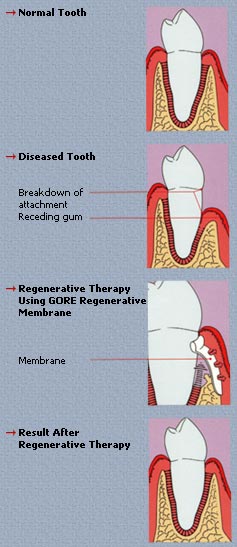Bone grafts
Bone grafts are done to replace the lost bone. This lost portion of bone is called a “bony defect”. As destruction caused by periodontal disease, defects after tooth extraction, generalized decrease in the quantity of jawbone if the teeth has been extracted a long back or in the young age, defects around dental implants, defects resulting from cysts or tumor surgery.

Barrier membranes
In conjunction with bone grafting, membranes are often used to help stabilize the bone graft as well as to displace the gum tissue from invading the healing bone graft before it matures. Use of barrier membrane is known as Guided tissue regeneration or GTR. Membranes place around teeth are typically designed to dissolve away, or reabsorb, after several weeks of healing have passed.
How does it works?
A bone graft is a surgical procedure that replaces missing bone with material from your own body (autogenous bone) or an artificial, synthetic, or natural substitute. A biocompatible membrane is placed between the gum and bone which acts as a barrier. This barrier prevents the growth of the gum tissue from limiting the growth of the underlying bone as it heals.
A bone graft not only replaces missing bone, but also helps your body to regrow its own lost bone. This new bone growth strengthens the grafted area by forming a bridge between your existing bone and the graft material. Over time your own newly formed bone will replace much of the grafted material.
When do one need a bone graft and/or GTR?
Bone grafting is generally required in cases:
- The bone loss / destruction caused by periodontal disease around the teeth,
- Bone loss following trauma,
- Bone defect in region of extraction done a long back,
- To augment bone in implant site
- During sinus lift process before implant placement,
- To enhance the fit and comfort of removable prostheses,
- To enhance esthetics of a missing tooth site in the smile zone,
- Following extraction, in case implant is planned.
What are the types of bone graft?
- Autogenous-means self. Bone harvested from one area of the patient and transplanted to another area.
- Allograft– either synthetic bone or bone from a bone bank.
- Xenograft– bovine bone.
Best Dental implants center in madurai and the greatest long term success or patients seeking cosmetic dental treatments and rehabilitation of lost teeth.
